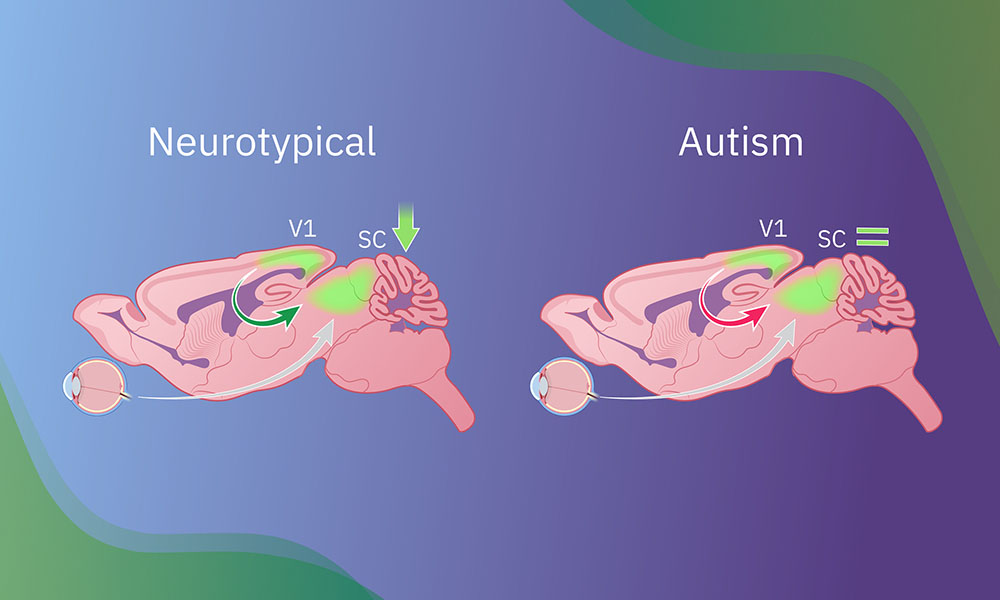Atypical cortical feedback underlies failure to process contextual information in the superior colliculus of Scn2a+/- autism model mice
Nat Commun 30/09/2025
10.1038/s41467-025-63788-2
A new study from EMBL Rome scientists reveals a specific brain circuit involved in impaired sensory learning and behavioural adaptation in autism

The brain constantly integrates past experiences with new information to help us make sense of the world. This process is especially important for guiding our behaviour and making decisions in unpredictable situations. Autistic individuals often struggle with unexpected changes and unpredictable situations. This might be related to an atypical integration process.
Autism has been studied from many angles, ranging from the genetic mutations that predispose individuals to the neurodevelopmental condition to the behavioural differences that emerge in learning and perception. However, the role of specific brain circuits in learning impairments in autism has remained largely unproven – often hypothesised but never really demonstrated.
A new study by Leiron Ferrarese and Hiroki Asari at EMBL Rome addresses this gap by identifying an atypical brain circuit that underlies learning impairments in a genetic mouse model of autism.
The researchers compared wild-type mice with mice carrying a mutation in the SCN2A gene – one of the genes most strongly linked to autism in humans. These mice are considered a reliable model for studying autism as they exhibit a range of autistic-like behaviours, such as atypical social interactions.
In this new study, both groups of mice were tested on visual learning tasks designed to assess their ability to learn stimulus sequences presented in either predictable or unpredictable patterns. During the test, mice were shown specific shapes on a screen, each associated with either a neutral or an aversive visual stimulus, the latter being a looming shadow simulating an approaching predator. The mice had to learn to predict the aversive stimulus using the specific shape presented as a cue. In the unpredictable condition, the cues no longer reliably predicted the aversive stimulus, preventing anticipation. As expected, the autism mouse model showed a clear impairment in learning ability in these tasks.
To uncover the neurological mechanism behind this difference, the researchers focused on the superior colliculus — a midbrain structure that transforms visual signals from the retina into motor responses by integrating attentional input from the cortex as well as information from other sensory areas in the brain. This brain circuit controls instinctive responses, enabling animals to react fast to potential threats, such as looming shadows, prioritising survival over conscious vision.
In wild-type mice, neurons in the superior colliculus showed reduced activity in response to predictable stimulus patterns, an adaptive mechanism that likely prevents overreaction to familiar events. When the stimulus patterns became unpredictable, these neurons regained sensitivity, allowing the mice to adjust their behaviour appropriately.
In contrast, the autism model mouse showed atypical responses during the learning task. Neurons in their superior colliculus remained overly active and failed to adapt to predictable stimuli, whereas they became even more reactive under unpredictable conditions. Notably, such atypical neuronal responses were associated with atypical cortical signalling to the superior colliculus. When this cortical connection was blocked, the wild-type mice failed to adapt their responses according to the changing conditions, much as in the autism model mice.
These results suggest that cortical input to the superior colliculus plays a critical role in integrating contextual information and modulating sensory learning. When this pathway is disrupted — as in the autism mouse model — atypical responses to uncertainty arise as commonly seen in autistic individuals.
This study offers the first direct evidence of a long-sought connection between a specific genetic mutation, changes in brain circuit function, and learning impairment in autism — paving the way for a deeper mechanistic understanding of this neurodevelopmental condition.
Nat Commun 30/09/2025
10.1038/s41467-025-63788-2